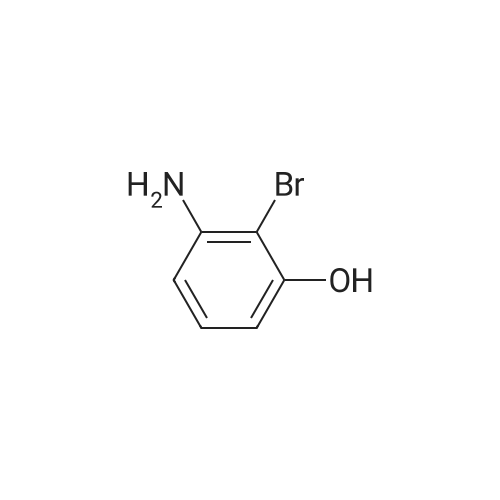Cat.NO.:A729251 Purity:95%
Product Details of [ 100367-36-0 ]
| CAS No. : | 100367-36-0 |
| Formula : |
C6H6BrNO |
| M.W : |
188.02
|
| SMILES Code : | OC1=CC=CC(N)=C1Br |
| MDL No. : | MFCD11846453 |
| InChI Key : | ZSNIVQDQECTJAJ-UHFFFAOYSA-N |
| Pubchem ID : | 459240 |
Safety of [ 100367-36-0 ]
| GHS Pictogram: |  |
| Signal Word: | Warning |
| Hazard Statements: | H302-H315-H319 |
| Precautionary Statements: | P261-P305+P351+P338 |
Computational Chemistry of [ 100367-36-0 ] Show Less
Physicochemical Properties
| Num. heavy atoms | 9 |
| Num. arom. heavy atoms | 6 |
| Fraction Csp3 | 0.0 |
| Num. rotatable bonds | 0 |
| Num. H-bond acceptors | 1.0 |
| Num. H-bond donors | 2.0 |
| Molar Refractivity | 40.57 |
| TPSA ?
Topological Polar Surface Area: Calculated from |
46.25 Ų |
Lipophilicity
| Log Po/w (iLOGP)?
iLOGP: in-house physics-based method implemented from |
1.47 |
| Log Po/w (XLOGP3)?
XLOGP3: Atomistic and knowledge-based method calculated by |
1.58 |
| Log Po/w (WLOGP)?
WLOGP: Atomistic method implemented from |
1.74 |
| Log Po/w (MLOGP)?
MLOGP: Topological method implemented from |
1.58 |
| Log Po/w (SILICOS-IT)?
SILICOS-IT: Hybrid fragmental/topological method calculated by |
1.34 |
| Consensus Log Po/w?
Consensus Log Po/w: Average of all five predictions |
1.54 |
Water Solubility
| Log S (ESOL):?
ESOL: Topological method implemented from |
-2.49 |
| Solubility | 0.602 mg/ml ; 0.0032 mol/l |
| Class?
Solubility class: Log S scale |
Soluble |
| Log S (Ali)?
Ali: Topological method implemented from |
-2.16 |
| Solubility | 1.29 mg/ml ; 0.00689 mol/l |
| Class?
Solubility class: Log S scale |
Soluble |
| Log S (SILICOS-IT)?
SILICOS-IT: Fragmental method calculated by |
-2.32 |
| Solubility | 0.906 mg/ml ; 0.00482 mol/l |
| Class?
Solubility class: Log S scale |
Soluble |
Pharmacokinetics
| GI absorption?
Gatrointestinal absorption: according to the white of the BOILED-Egg |
High |
| BBB permeant?
BBB permeation: according to the yolk of the BOILED-Egg |
Yes |
| P-gp substrate?
P-glycoprotein substrate: SVM model built on 1033 molecules (training set) |
No |
| CYP1A2 inhibitor?
Cytochrome P450 1A2 inhibitor: SVM model built on 9145 molecules (training set) |
No |
| CYP2C19 inhibitor?
Cytochrome P450 2C19 inhibitor: SVM model built on 9272 molecules (training set) |
No |
| CYP2C9 inhibitor?
Cytochrome P450 2C9 inhibitor: SVM model built on 5940 molecules (training set) |
No |
| CYP2D6 inhibitor?
Cytochrome P450 2D6 inhibitor: SVM model built on 3664 molecules (training set) |
No |
| CYP3A4 inhibitor?
Cytochrome P450 3A4 inhibitor: SVM model built on 7518 molecules (training set) |
Yes |
| Log Kp (skin permeation)?
Skin permeation: QSPR model implemented from |
-6.33 cm/s |
Druglikeness
| Lipinski?
Lipinski (Pfizer) filter: implemented from |
0.0 |
| Ghose?
Ghose filter: implemented from |
None |
| Veber?
Veber (GSK) filter: implemented from |
0.0 |
| Egan?
Egan (Pharmacia) filter: implemented from |
0.0 |
| Muegge?
Muegge (Bayer) filter: implemented from |
1.0 |
| Bioavailability Score?
Abbott Bioavailability Score: Probability of F > 10% in rat |
0.55 |
Medicinal Chemistry
| PAINS?
Pan Assay Interference Structures: implemented from |
0.0 alert |
| Brenk?
Structural Alert: implemented from |
1.0 alert: heavy_metal |
| Leadlikeness?
Leadlikeness: implemented from |
No; 1 violation:MW<1.0 |
| Synthetic accessibility?
Synthetic accessibility score: from 1 (very easy) to 10 (very difficult) |
1.14 |
Application In Synthesis of [ 100367-36-0 ]
* All experimental methods are cited from the reference, please refer to the original source for details. We do not guarantee the accuracy of the content in the reference.
- Upstream synthesis route of [ 100367-36-0 ]
- Downstream synthetic route of [ 100367-36-0 ]
[ 100367-36-0 ] Synthesis Path-Upstream 1~5
| Yield | Reaction Conditions | Operation in experiment |
|---|---|---|
| 43.9% | With iron; acetic acid In ethanolReflux | [00408] 2-Bromo-3-nitro-phenol (3.35 g, 15.4 mmol), acetic acid (35 mL) and iron powder(4.5 g, 77.2 mmol) were stirred in ethanol (50 mL) under reflux overnight. The mixture was diluted with 1 00m1 of water and neutralised with potassium carbonate before extraction with DCM. The organics were dried with sodium sulfate and concentrated in vacuo to leave the crude product as a brown oil. This was dry-packed on to silica and purified by columnchromatography using a 0-50percent gradient of ethyl acetate in isohexane. The resulting fragments were concentrated in vacuo to give 3-amino-2-bromo-phenol (1 .27 g, 6.75 mmol, 43.9percent) as a pale yellow solid.[00409] 1H NMR (DMSO-d6): O 7.02 (t, J = 8.0 Hz, 1H), 6.45 (dd, J= 1.6 and 8.0 Hz,1 H), 6.38 (dd, J = 1 .6 and 8.0 Hz, 1 H) 5.44 (bs, 1 H), 4.89 (bs, 2H). |
[1] Journal of Organic Chemistry, 1988, vol. 53, # 6, p. 1170 – 1176.
[2] Chemistry – A European Journal, 2017, vol. 23, # 42, p. 9996 – 10000.
[3] Patent: WO2015/79251, 2015, A1, . Location in patent: Paragraph 00408; 00409.
[1] Farmaco, 1995, vol. 50, # 6, p. 425 – 430.
[2] Journal of the American Chemical Society, 1995, vol. 117, # 25, p. 6666 – 6672.
[1] Journal of the American Chemical Society, 1995, vol. 117, # 25, p. 6666 – 6672.
[2] Farmaco, 1995, vol. 50, # 6, p. 425 – 430.
[1] Journal of the American Chemical Society, 1995, vol. 117, # 25, p. 6666 – 6672.
[2] Farmaco, 1995, vol. 50, # 6, p. 425 – 430.









Reviews
There are no reviews yet.